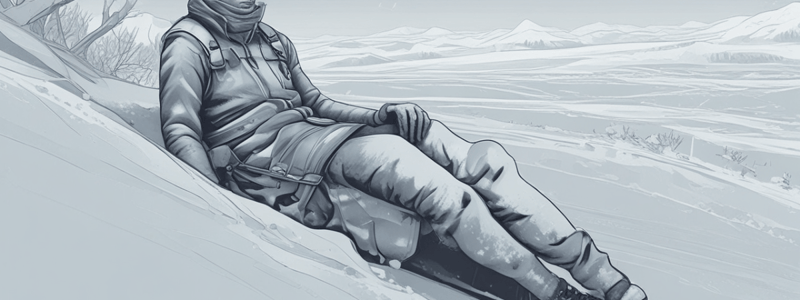Podcast
Questions and Answers
What are common symptoms of cold stress?
What are common symptoms of cold stress?
- Rash, itching, and dry skin
- Numbness, tingling, and aching (correct)
- Sneezing, coughing, and fever
- Headache, dizziness, and blurred vision
How can cold stress be prevented?
How can cold stress be prevented?
- Wearing appropriate clothing and using warm break areas (correct)
- Exercising outdoors without proper equipment
- Avoiding sunlight exposure during cold weather
- Drinking cold water regularly
What factors can contribute to cold stress?
What factors can contribute to cold stress?
- Excessive exposure to sunlight
- Consuming spicy foods
- High humidity and excessive sweating
- Hypertension, hypothyroidism, and diabetes (correct)
Why is it important to avoid skin contact with cold metal surfaces in cold environments?
Why is it important to avoid skin contact with cold metal surfaces in cold environments?
What should employers do to help prevent cold stress in the workplace?
What should employers do to help prevent cold stress in the workplace?
Flashcards are hidden until you start studying
Study Notes
Cold stress occurs when the body's core temperature drops below the normal range of 98.6°F (37°C), leading to a variety of health issues. The most common conditions associated with cold stress include hypothermia, frostbite, and trench foot. These conditions can occur when the body is exposed to cold temperatures, wind, dampness, and cold water for extended periods.
Hypothermia occurs when body heat is lost faster than it can be replaced, resulting in a core temperature below 95°F (35°C). Early signs and symptoms include shivering, fatigue, and confusion or disorientation, which can evolve into more severe symptoms like blue skin, a slow pulse, and even loss of consciousness. Hypothermia is most likely to occur at very cold temperatures and should be treated by gradually warming the affected individual and seeking emergency medical help.
Frostbite is characterized by the freezing of skin and other tissues, most commonly affecting the nose, ears, fingers, cheeks, and toes. It can occur in less than 30 minutes when skin is exposed to cold temperatures. Early signs and symptoms include numbness, itching, and burning of the skin, which can progress to blistering, hardening, and even necrosis of the affected areas. Treatment involves removing the affected person from the cold, warming the affected skin in warm (not hot) water, and seeking emergency medical help.
Trench foot is caused by extended exposure to cold, damp environments that are just above freezing. It is similar to frostbite but less severe. Symptoms include numbness, tingling, and aching of the affected areas, which can progress to a feeling of warmth, confusion, and lack of coordination. Treatment includes removing the affected person from the cold, warming the affected areas, and seeking medical attention.
Cold stress can also result from factors such as wetness, exhaustion, and predisposing health conditions like hypertension, hypothyroidism, and diabetes. These conditions can be exacerbated by poor physical conditioning and exposure to wet environments.
Prevention measures include wearing appropriate clothing, using multiple layers of moisture-wicking clothing, avoiding skin contact with cold metal surfaces, using warm break areas, and carrying cold weather gear like hats, jackets, and gloves. Employers should also provide training and education on cold stress, monitor workers, and provide additional resources such as warm liquids and relief workers for long, demanding jobs.
Studying That Suits You
Use AI to generate personalized quizzes and flashcards to suit your learning preferences.




